Importing a car from Japan to Uganda can save you money but requires careful planning. Here’s what you need to know:
- Key Costs: Total expenses include the car’s price, shipping, insurance, customs duties (25% of CIF value), and VAT (18% of duty). For example, a car with a $10,000 CIF value would cost around $12,950 after taxes.
- Regulations: Uganda enforces a 15-year age limit on imported vehicles and requires pre-shipment inspections (JEVIC) for roadworthiness and emissions compliance. Missing these can lead to penalties.
- Documents: Essential paperwork includes the commercial invoice, bill of lading, export certificate, JEVIC certificate, proof of insurance, and customs clearance forms.
- Timeline: The entire process, from purchase to registration in Kampala, takes about 6–10 weeks.
- Tips: Work with reliable shipping companies, budget for extra costs, and stay updated on Uganda Revenue Authority (URA) rules to avoid surprises.
Finally a NEW CAR! | Step by Step: Importing a Car from Japan to Uganda

Uganda’s Car Import Rules and Requirements
If you’re planning to import a car into Uganda from Japan, it’s important to familiarize yourself with the country’s import regulations. These rules are designed to ensure vehicles meet specific quality and safety standards. Ignoring them could result in your car being denied entry or subject to extra charges.
Required Inspections and Certifications
Before your car leaves Japan, it must pass an inspection conducted by the Japan Export Vehicle Inspection Center (JEVIC). This is part of Uganda’s Pre-Export Verification of Conformity (PVoC) program, which requires two key certifications: the Certificate of Conformity (COC) and the Certificate of Road Worthiness (CRW). Both must be issued by an approved inspection agent.
Keep this in mind: if your car arrives in Uganda without PVoC certification, you’ll face a 15% surcharge on the CIF (Cost, Insurance, and Freight) value, along with additional inspection fees.
Once these steps are completed, you’ll need to address Uganda’s local insurance and registration requirements.
Local Insurance and Registration Requirements
After your vehicle arrives in Kampala, you’ll need to register it through the Uganda Revenue Authority (URA). This can be done online at www.ura.go.ug or by visiting a regional URA office. Be prepared to provide all necessary import documents, including customs clearance papers and the certificates you obtained during the inspection process.
Uganda requires you to purchase local insurance, as policies from other countries are not accepted. Additionally, you’ll need to acquire Ugandan license plates. Standard plates are included in the registration fee, but if you’re looking for something more personalized, custom plates are available for UGX 20,000,000 (around $5,400).
Complete Cost Breakdown for Car Imports
Importing a car from Japan to Uganda involves more than just the purchase price. To get a clear picture of the total cost, you need to account for multiple components. The Uganda Revenue Authority (URA) uses the CIF value – a combination of the vehicle’s cost, insurance, and freight charges – to calculate the taxes and duties you’ll owe.
Cost, Insurance, and Freight (CIF)
The CIF value forms the basis of your import cost. It includes:
- The vehicle’s purchase price
- Shipping insurance
- Freight charges to Uganda’s port
"The CIF price covers the cost until the destination port, prior to customs clearance." – CAR FROM JAPAN
Freight charges can vary depending on the shipping company, the type of vessel, and seasonal demand. Additionally, ensuring full shipment insurance is critical to protect your investment. Once you know your CIF value, Uganda applies its taxes and duties to calculate the final costs.
Taxes and Duties
Uganda’s taxes and duties are calculated based on the CIF value. Here’s how they break down:
- Customs Duty: Typically 25% of the CIF value.
- Value Added Tax (VAT): Calculated at 18%, but only on the customs duty amount – not the CIF value itself.
"When importing a vehicle into Uganda, various taxes and duties apply. These are calculated based on the Cost, Insurance, and Freight (CIF) value of the vehicle, which includes the purchase price, insurance, and shipping costs." – Autocj.co.jp
Cost Calculation Example
Let’s look at an example using a Toyota Camry with a CIF value of $10,000:
| Cost Component | Calculation | Amount |
|---|---|---|
| CIF Value | Purchase + Insurance + Freight | $10,000 |
| Import Duty (25%) | $10,000 × 0.25 | $2,500 |
| VAT (18% of duty) | $2,500 × 0.18 | $450 |
| Total Taxes & Duties | $2,950 |
In this case, the total cost for a $10,000 CIF value would be $12,950. Keep in mind that actual costs may vary depending on the vehicle’s specifications and any changes in tax policies.
Customs Clearance and Required Documents
Bringing an imported car through customs involves careful planning and having the right paperwork in order. Being prepared ahead of time can save you from unnecessary delays at the port.
Required Documents for Import
To clear customs for your vehicle, make sure you have the following essential documents:
- Original Commercial Invoice: This document, provided by the Japanese dealer, serves as proof of purchase and indicates the vehicle’s value. It must align perfectly with your shipping records.
- Bill of Lading: Issued by your shipping company, this document acts as a receipt for the shipping service and proves ownership of the vehicle.
- Export Certificate from Japan: This certificate confirms the vehicle was legally exported and includes details such as the VIN, engine number, and export date.
- JEVIC Inspection Certificate: This certificate verifies the vehicle’s condition, age, and compliance with Uganda’s import standards. It must be obtained before the vehicle leaves Japan.
- Proof of Marine Insurance: Ensure your marine insurance covers the full CIF (Cost, Insurance, and Freight) value until the vehicle reaches Uganda.
- Additional Documents: These include your passport or national ID, an import permit from the Uganda Revenue Authority (URA), and proof of payment for any advance duties or fees.
Once you’ve gathered these documents, you’re ready to proceed with customs clearance.
Customs Clearance Process
When your vehicle arrives at the port – usually Mombasa Port in Kenya or Dar es Salaam Port in Tanzania, depending on your shipping route – you’ll need to present all the required documents to customs officials. They will verify these documents against the physical vehicle, ensuring details like the VIN and engine number match.
The Uganda Revenue Authority will calculate your final duty and tax obligations based on the vehicle’s CIF value. These fees must be paid before the car can be released. Payments can be made through authorized banks or mobile money services.
After clearing customs at the port, your vehicle will be transported to Uganda. At the border crossings, a final customs inspection will be conducted. Once cleared, complete the URA registration process in Kampala to receive your license plates and registration certificate.
Import Process Timeline
Planning your timeline is key to ensuring a smooth clearance and registration process. Here’s a breakdown of the steps involved:
| Stage | Duration | Key Activities |
|---|---|---|
| Purchase & Documentation | 1–2 weeks | Select vehicle, make payment, and complete JEVIC inspection. |
| Shipping from Japan | 3–4 weeks | Ocean freight to ports in East Africa. |
| Port Clearance | 3–7 days | Customs inspection, duty payment, and document verification. |
| Inland Transport | 2–3 days | Trucking the vehicle from the port to Uganda’s border. |
| Border Clearance | 1–2 days | Final customs inspection and import stamp. |
| Kampala Registration | 1–3 days | URA registration, license plates, and insurance. |
The entire process typically takes about 6 to 10 weeks from the time you purchase your vehicle in Japan to when it’s ready to drive in Kampala. However, this timeline can vary due to seasonal factors, weather conditions, or port congestion. It’s wise to plan for possible delays and budget for temporary transportation in Kampala if needed. Avoid timing your import if you have a strict deadline for the vehicle’s arrival.
sbb-itb-7bab64a
Selecting Shipping and Inspection Services
When importing vehicles from Japan to Uganda, working with experienced shipping and inspection providers is essential. These partners handle the transit process and ensure your vehicle meets all regulatory requirements.
Finding Reliable Shipping Companies
To ensure a smooth import process, partner with a shipping company that has extensive experience in vehicle exports from Japan to Uganda. Such companies are well-versed in international shipping protocols and Uganda’s specific import requirements. Ask about their shipping options and request references from previous customers to gauge their reliability. Additionally, confirm that your vehicle complies with Uganda’s standards by scheduling the mandatory JEVIC inspection.
JEVIC Inspections Explained
A JEVIC inspection is a critical step in securing the Certificate of Conformity (COC), which is required to import vehicles into Uganda. This pre-shipment inspection ensures that your vehicle meets Uganda’s roadworthiness and safety standards before leaving Japan.
The inspection process includes several checks, such as odometer verification and assessments of the brakes, suspension, steering, and lighting systems. Emissions testing is also conducted to ensure compliance with Uganda’s environmental regulations. Vehicles exceeding acceptable emission levels may either be denied entry or require modifications before registration. Once your vehicle passes, you’ll receive the COC, a document necessary for customs clearance.
To avoid delays, schedule your JEVIC inspection immediately after purchasing your vehicle in Japan. If the vehicle fails, you must address the highlighted issues and arrange a re-inspection. This process can add 1–2 weeks to your timeline and cost an additional $150 to $300. Passing this inspection is vital for a smooth shipping process.
Using AutoMag.ug for Trusted Recommendations

AutoMag.ug is a valuable resource for navigating the vehicle import process. The platform offers detailed reviews and trusted recommendations for shipping companies and other service providers who understand Uganda’s import procedures.
Tips for Smooth Car Imports in Kampala
Bringing a car from Japan to Uganda can be a straightforward process – if you plan carefully. Avoiding common mistakes and staying informed about changing regulations will save you time, money, and headaches.
Common Mistakes to Avoid
Here are some frequent pitfalls that can complicate your car import experience:
- Check vehicle age compliance: Cars that don’t meet Uganda’s age limit regulations can be rejected at shipment, causing delays and additional costs.
- Ensure all documentation is complete: Missing paperwork can lead to customs clearance delays and hefty port storage fees.
- Schedule JEVIC inspections on time: Delaying mandatory inspections like those from the Japan Export Vehicle Inspection Center (JEVIC) can create customs issues and disrupt your timeline.
- Plan your budget wisely: Factor in all costs beyond the car’s purchase price, such as taxes, shipping, and inspection fees. Choosing service providers based solely on low prices can result in hidden charges and poor-quality service.
Staying Updated on Rule Changes
Uganda’s import rules are subject to frequent updates, making it essential to stay informed. Keep an eye on announcements from the Uganda Revenue Authority (URA) and the Ministry of Works and Transport.
Local news outlets are also a valuable resource. For example, in August 2025, the Daily Monitor highlighted potential changes to heavy-duty vehicle import rules and advised readers to:
"Stay updated by following our WhatsApp and Telegram channels".
Subscribing to digital news platforms and consulting experienced clearing agents can help you stay ahead of any regulatory shifts.
Getting Local Insights from AutoMag.ug
Beyond understanding regulations, tapping into local expertise can make the process smoother. AutoMag.ug is a trusted source for automotive information tailored to Uganda. In March 2025, they released a comprehensive guide titled "Importing a Car to Uganda: Everything You Need to Know," covering essential topics like age restrictions, roadworthiness checks, and taxation.
For more tips and insights:
"For more automotive insights tailored to Uganda, visit Automag Uganda".
Conclusion: Your Car Import Success Plan
Bringing a car from Japan to Uganda involves more than just picking the right vehicle – it’s about planning every step carefully. To make the process as seamless as possible, it’s essential to understand the costs involved and ensure compliance with all regulations.
The total cost of importing a car includes much more than the purchase price. Import duties can reach up to 25%, VAT is set at 17%, and additional fees may add another 30–40% or more to your expenses. Uganda enforces a strict 15-year age limit on imported vehicles and requires JEVIC inspections. Non-compliance can result in penalties as high as 15% of the CIF value. Proper documentation, including inspection certificates and the original logbook, is non-negotiable if you want to avoid delays and costly storage fees at the port.
On top of these essentials, having access to reliable local insights can make a big difference. Platforms like AutoMag.ug offer up-to-date information on regulations, trusted service provider recommendations, and expert advice to help you avoid common mistakes. In fact, more than 80% of successful imports in 2024 were handled by agents recommended by trusted platforms, highlighting the importance of working with knowledgeable professionals.
Ultimately, your success in importing a car lies in thorough preparation, staying compliant with Uganda’s import rules, and leveraging expert resources. By understanding the full scope of costs and tapping into AutoMag.ug’s trusted guidance, you can ensure your Japanese vehicle arrives in Kampala smoothly and cost-effectively.
FAQs
What happens if I don’t get the required JEVIC inspection before importing a car to Uganda?
If you skip the JEVIC inspection before importing a car to Uganda, you could run into some major problems. These might include a 15% penalty on the CIF value of your vehicle, delays in customs processing, or, worse, your car being turned away at the port.
To steer clear of these headaches, make sure your vehicle is inspected before shipping. Doing so helps you avoid unnecessary costs and delays while staying compliant with Uganda’s import rules.
How do I ensure my car meets Uganda’s 15-year import age limit?
To meet Uganda’s regulation on imported vehicles, ensure the car’s Year of Manufacture (YOM) is 2010 or later. Vehicles manufactured before 2010 are prohibited from entering the country. Always carefully review the YOM on the vehicle’s paperwork and confirm it with the seller to prevent complications during customs clearance.
What should I do if my car import from Japan to Uganda is delayed in customs?
If your car import gets held up in customs, the first step is to double-check that all your paperwork is in order. This includes essential documents like the bill of lading, invoice, and import declaration forms. Any errors or missing details in these can slow things down significantly.
Consider working with a licensed clearing agent. These professionals know Uganda’s customs system inside and out, which means they can help you navigate the process and resolve issues faster.
Make it a habit to track your shipment frequently and reach out to the Uganda Revenue Authority (URA) if you need updates or assistance. Also, ensure your car complies with all import rules, such as restrictions on age and emissions, to avoid unexpected setbacks. Staying on top of these steps can save you time, money, and frustration.
Related posts
- How to Import a Car to Uganda: Complete Guide 2025
- How to register a used car in Uganda
- Importing a car to Uganda: taxes explained
- What You Need to Know Before Buying a Car in Uganda




